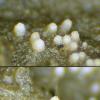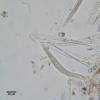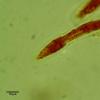
13-10-2010 11:44
 Martin Bemmann
Martin Bemmann
Dear all, some days ago I collected a fragment

30-09-2010 21:47
 Raúl Tena Lahoz
Raúl Tena Lahoz
On Populus nigra rotten leaves, on August 22, 2010

29-09-2010 22:56
 Michel Hairaud
Michel Hairaud
Hi to all, Would anyone help me with this disc

27-09-2010 13:19
 Beñat Jeannerot
Beñat Jeannerot
Bonjour à tous, J'ai besoin d'avoir des préci

21-09-2010 12:46
 Alex Akulov
Alex Akulov
Dear Colleagues. Please advise, what could be the
White aquatic/semiaquatic
Martin Bemmann,
13-10-2010 11:44
 Dear all,
Dear all,some days ago I collected a fragment of deciduous wood, rotten and decorticated, still hard in the core, lying half submerged in a small clean creek. Among the fungi detectected were Orbilia sarraziniana/luteorubella, Hymenoscyphus cf. imberbis and still a lot more, unknown to me.
Here is the first one:
Ascomata are sessile, gregarious with a whitish soft and gelatinous peridium (like Nectria) < 0,5 mm dm.
Asci are bitunicate, containing 8 spores lying in 2 fascicles.
Spores are elongated fusi- to filiform with tendency to break in the middle, 123x3 µm.
Every suggestion is appreciated!
Reagards,
Martin
Bernard Declercq,
13-10-2010 14:05

Re:White aquatic/semiaquatic
Tubeufia like species. Maybe T. paludosa?
Bernard
Bernard
Martin Bemmann,
13-10-2010 14:22

Re:White aquatic/semiaquatic
Thank you Bernard!
With the keys provided in Rossman 1987 I arrive directly at T. paludosa.
Best regards,
Martin
With the keys provided in Rossman 1987 I arrive directly at T. paludosa.
Best regards,
Martin



